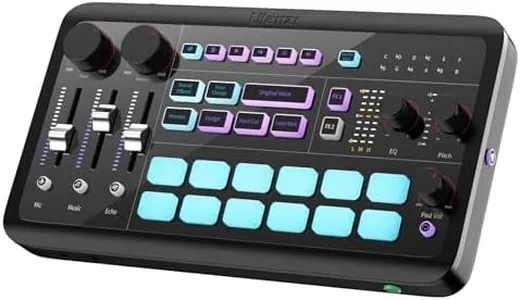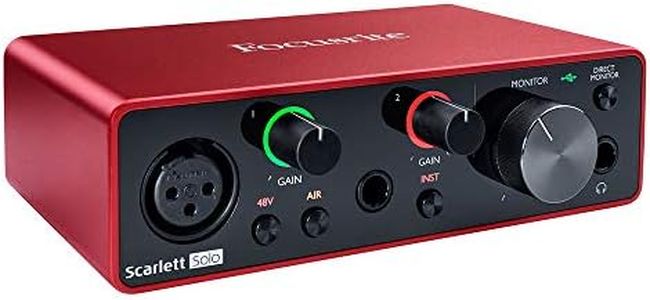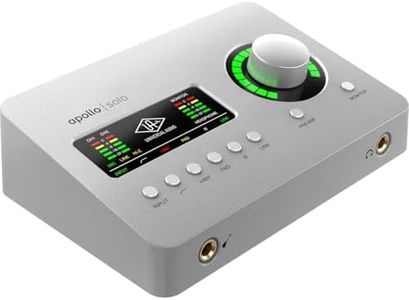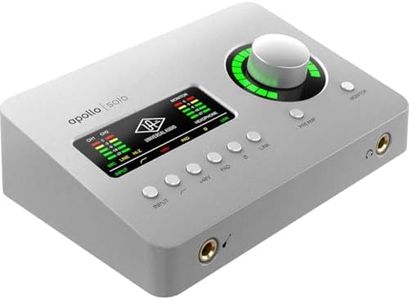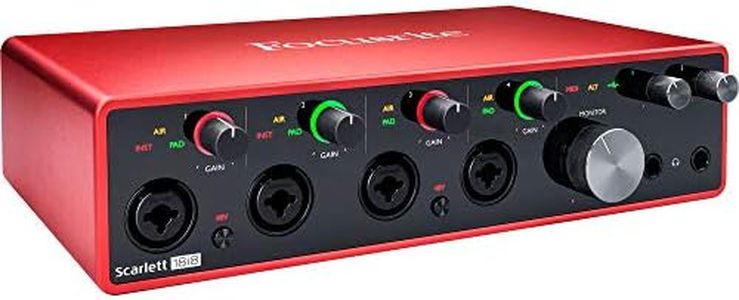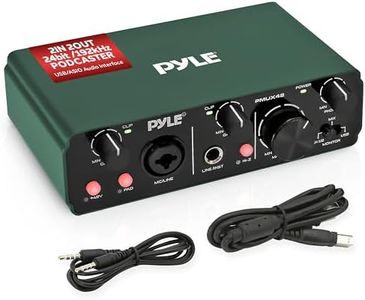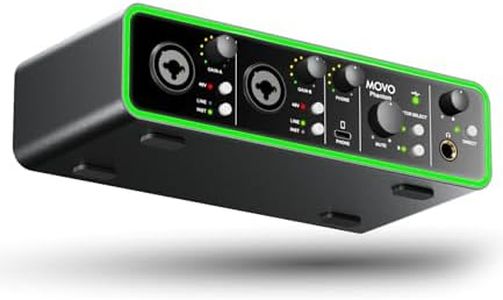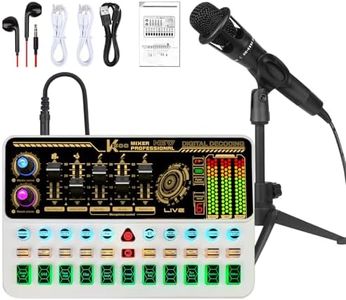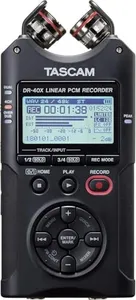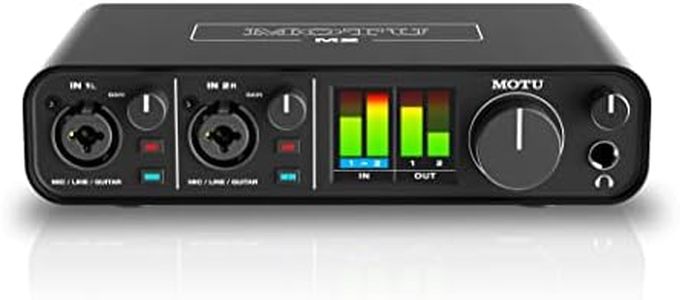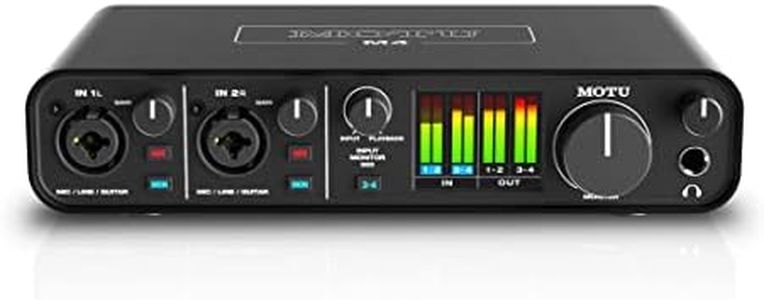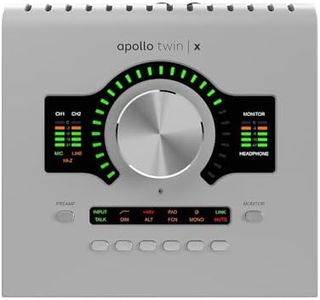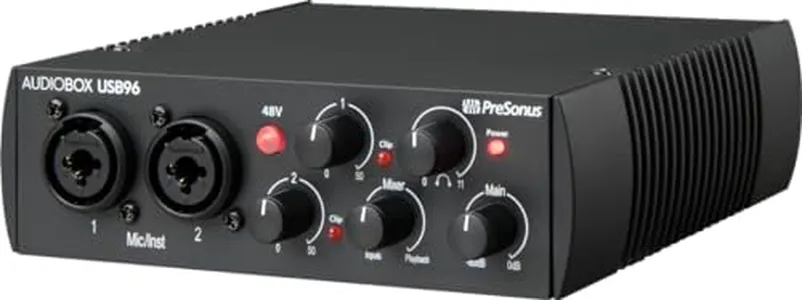10 Best Audio Interfaces 2025 in the United States
Our technology thoroughly searches through the online shopping world, reviewing hundreds of sites. We then process and analyze this information, updating in real-time to bring you the latest top-rated products. This way, you always get the best and most current options available.

Our Top Picks
Winner
Focusrite Scarlett Solo 3rd Gen USB Audio Interface for Guitarists, Vocalists, Podcasters or Producers to record and playback studio quality sound
Most important from
27502 reviews
The Focusrite Scarlett Solo 3rd Gen USB Audio Interface is a solid choice for musicians, podcasters, and producers looking for high-quality audio recording in a compact package. One of its standout features is the impressive audio quality, capable of 24-bit/192kHz recording, ensuring your projects sound professional. The built-in high-performance mic pre-amps, along with the switchable Air mode, add clarity to recordings, making it especially beneficial for vocalists and acoustic instrument players. The interface also boasts two instrument inputs with Gain Halos, preventing distortion and ensuring clear sound capture.
In terms of connectivity, the USB-C interface is convenient and compatible with various operating systems, including Windows, Mac OS, and iOS, which opens the door for diverse usage scenarios. The low-noise balanced outputs deliver crystal-clear playback, allowing you to appreciate every detail in your mixes. Additionally, the included Easy Start tool helps users quickly set up their recording environment, which is great for beginners.
The Scarlett Solo has its limitations. It only offers two inputs, meaning it may not be ideal for users needing to record multiple instruments or voices simultaneously. While it provides high-quality sound, some users may desire more advanced features or additional inputs as they progress in their audio journey. The portability, while decent, may not be suitable for heavy use in rugged environments. Another potential drawback is the reliance on software compatibility for full functionality, which may be challenging for those unfamiliar with audio recording programs. However, the three-year warranty gives peace of mind for potential hardware issues. The Focusrite Scarlett Solo 3rd Gen is a fantastic option for those starting in audio recording, providing excellent quality and ease of use, but may not fully meet the needs of more advanced users.
Most important from
27502 reviews
Focusrite Scarlett 18i20 4th Gen USB Audio Interface
Most important from
2855 reviews
The Focusrite Scarlett 18i20 4th Gen USB Audio Interface is a robust choice for anyone involved in multitrack recording, music production, or podcasting. It offers an impressive 18 inputs and 20 outputs, which is excellent for complex audio setups. The inclusion of eight high-quality mic preamps, versatile connectivity options like Hi-Z, line inputs, ADAT, S/PDIF, MIDI I/O, and Word Clock, makes it highly adaptable for various recording scenarios.
The audio quality is top-notch with 24-bit, 192kHz converters and a 122dB dynamic range, ensuring detailed and high-fidelity recordings. The Air mode feature is a significant plus, adding classic studio console character to vocals and instruments, elevating the sound quality. Additionally, the Auto Gain and Clip Safe features are incredibly useful for maintaining optimal recording levels and preventing audio clipping, enhancing the recording workflow. The interface is compatible with all major audio recording software and comes with a comprehensive software bundle, including Pro Tools Intro+, Ableton Live Lite, and FL Studio Producer Edition, adding significant value.
The build quality is solid with an aluminum body, and while it's not the lightest interface at 8.04 pounds, it is durable and built to last. The USB-C connectivity ensures fast data transfer, though some users may need to ensure they have the necessary ports on their devices. One potential drawback could be its size, which might be cumbersome for those with limited space or who need a highly portable setup. Despite this, the Scarlett 18i20's blend of high-quality audio, versatile connectivity, and professional-grade features makes it an excellent choice for both home studios and professional environments.
Most important from
2855 reviews
Universal Audio Apollo Solo Heritage Edition, APLS-HE
Most important from
331 reviews
The Universal Audio Apollo Solo Heritage Edition (APLS-HE) is a well-regarded audio interface that offers several standout features. It includes UAD SOLO Core Processing which allows for near-zero latency tracking through a range of vintage compressors, EQs, tape machines, mic preamps, and guitar amp plug-ins. This is a significant advantage for those looking for high-quality audio processing during recording. The inclusion of a premium suite of 5 award-winning plug-in titles adds considerable value to the package, making it attractive for professionals seeking a comprehensive solution for audio production.
The Unison mic preamp and guitar amp emulations from renowned brands like Neve, API, and Marshall enhance its versatility. Additionally, the Apollo Solo is designed to integrate seamlessly with the LUNA Recording System (Mac only), though it's also compatible with other major DAWs like Logic Pro, Pro Tools, and Ableton Live, making it flexible in various recording environments. The bus-powered connection enhances portability, and the superior build quality ensures durability.
However, there are a few limitations. It only offers six channels and might not be sufficient for users needing more extensive input/output options. Its premium feature set is somewhat overkill for casual users or beginners who might not fully utilize the included plug-ins and processing power. Furthermore, while it boasts excellent compatibility with Mac systems, Windows users may find fewer advantages due to the lack of LUNA support. In summary, the Apollo Solo Heritage Edition is best suited for professional or semi-professional musicians and audio engineers who require high-quality audio processing and are looking for an integrated, portable solution.
Most important from
331 reviews
Buying Guide for the Best Audio Interfaces
Choosing the right audio interface is crucial for anyone involved in music production, podcasting, or any form of audio recording. An audio interface is a device that connects your instruments, microphones, and other audio gear to your computer, converting analog signals into digital data that your computer can process. To find the best fit for your needs, you should consider several key specifications. Understanding these specs will help you make an informed decision and ensure that your audio interface meets your specific requirements.FAQ
Most Popular Categories Right Now
